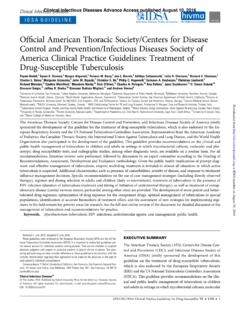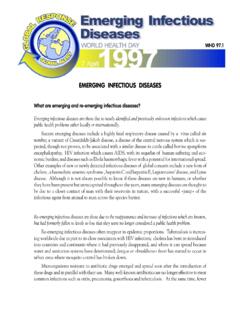Transcription of National Institutes of Health SBA-Approved SBIR/STTR ...
1 NIH, CDC, and FDA Program Descriptions and Research Topics Appendix A 1 National Institutes of Health SBA-Approved SBIR/STTR Topics for Awards over Statutory Budget Limitations 7/09/2020 NIH has received approval from SBA for the topics listed within for budgets greater than $256,580 for Phase I SBIR/STTR awards and greater than $1,710,531 for Phase II SBIR/STTR awards for 2020-2021. Applicants are strongly encouraged to contact NIH program officials prior to submitting any award budget in excess of these amounts. Applicants are also required to follow NIH Institute- and Center-specific budget guidance found in all SBIR and STTR funding opportunity announcements.
2 NIH, CDC, and FDA Program Descriptions and Research Topics Appendix A 2 Table of Contents National Cancer Institute (NCI) .. 3 National Center For Advancing Translational Sciences (NCATS) .. 4 National Center for Complementary and Integrative Health (NCCIH) .. 5 National Eye Institute (NEI) .. 6 National Heart, Lung, and Blood Institute (NHLBI) .. 7 National Human Genome Research Institute (NHGRI) .. 8 National Institute on Aging (NIA) .. 9 National Institute on Alcohol Abuse and Alcoholism (NIAAA) .. 13 National Institute of Allergy and Infectious Diseases (NIAID).
3 14 National Institute of Arthritis and Musculoskeletal and Skin Diseases (NIAMS) .. 17 National Institute of Biomedical Imaging and Bioengineering (NIBIB) .. 18 Eunice Kennedy Shriver National Institute of Child Health and Human Development (NICHD) .. 20 National Institute on Deafness and Other Communication Disorders (NIDCD) .. 22 National Institute of Dental and Craniofacial Research (NIDCR) .. 23 National Institute of Diabetes and Digestive and Kidney Diseases (NIDDK) .. 25 National Institute on Drug Abuse (NIDA) .. 26 National Institute of Environmental Health Sciences (NIEHS).
4 27 National Institute of General Medical Sciences (NIGMS) .. 28 National Institute of Mental Health (NIMH) .. 30 National Institute on Minority Health and Health Disparities (NIMHD) .. 34 National Institute of Neurological Disorders and Stroke (NINDS) .. 35 National Institute of Nursing Research (NINR) .. 37 National Library of Medicine (NLM) .. 38 Division of Program Coordination, Planning, and Strategic Initiatives (DPCPSI), Office of Research Infrastructure Programs (ORIP) .. 39 NIH, CDC, and FDA Program Descriptions and Research Topics Appendix A 3 National CANCER INSTITUTE (NCI) A.
5 Therapeutics ( Small Molecules, Biologics, Radiomodulators, Cell-based Therapies and Drug Development- Related IT Tool and Algorithm Development) B. In Vitro and In Vivo Diagnostics ( Companion Diagnostics, Prognostic Technologies, Treatment Monitoring and Diagnostic-Related IT Tool and Algorithm Development) C. Imaging Technologies ( Agents, Devices, Software Tools, Algorithm Development, and Image-Guided Interventions) D. Devices for Cancer Therapy ( Interventional Devices, Software Tools, Algorithm Development, Surgical, Radiation and Ablative Therapies) E.
6 Agents for Cancer Prevention ( , Vaccines, but not Technologies for Cancer Prevention ) F. Development of Low-Cost Technologies for Low-Resource Settings and Cancer Global Health G. Development of Digital Health Tools NIH, CDC, and FDA Program Descriptions and Research Topics Appendix A 4 National CENTER FOR ADVANCING TRANSLATIONAL SCIENCES (NCATS) A. Innovative platforms for identification and prioritization of targets for therapeutic intervention with clear clinical impact. B. Technologies to determine alternative uses for existing therapeutic interventions.
7 C. Tools and technologies to allow assaying of activities of compounds on currently non-druggable targets. D. Phenotypic assay development, including stem cell technology platforms for human disease in a dish applications and the evaluation of toxicity. E. Co-crystallization high-throughput screening techniques. F. Small molecule and biologics analytical characterization. G. Tools and technologies that increase the predictivity or efficiency of medicinal chemistry, biologic, or other intervention optimization. H. Accelerate bioengineering approaches to the development and clinical application of biomedical materials, devices, therapeutics, and/or diagnostics.
8 I. Tools and technologies that increase the efficiency of human subjects research, including development of technologies that facilitate rapid diagnosis and/or clinical trial recruitment and subject tracking, IRB evaluation, and/or regulatory processes. J. Novel platforms, technologies and tools for: (1) enabling clinical and translational research, particularly those with mechanisms for inclusion of patient reported data and (2) integration of patient data collected from multiple devices and multiple/diverse clinical studies. K. Searchable access to information about researchers and their expertise, including but not limited to their publications, published data sets, methods, patents, clinical trials, partnerships, collaborators, and clinical specialty/expertise (if applicable).
9 L. Tools for meaningful sharing of research data with low barrier for provision and user friendly access. M. Microphysiological Systems (MPS)/Tissue Chips. NIH, CDC, and FDA Program Descriptions and Research Topics Appendix A 5 National CENTER FOR COMPLEMENTARY AND INTEGRATIVE Health (NCCIH) A. Development and validation of biomarkers that correlate with efficacy of complementary Health approaches. B. Formulation, development, and clinical testing of complementary Health approaches and natural products that would permit FDA approval of a natural product for a specific indication.
10 C. Identification and validation of biological targets associated with complementary Health approaches. D. Development of innovative technologies and methods to assess natural product drug interactions in humans. E. Studies of the mechanistic effects of mind and body interventions that will allow for optimization of the efficacy and safety of the mind and body approach for commercialization. F. Nontraditional phenotypic assay development for complex natural product mixtures. G. Integrated in silico tools for exploiting natural product bioactivity.








